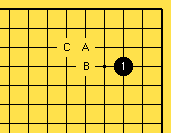
When visiting the Japanese go association of central Japan (Nihon Ki-in) I came to talk with Mr. Ikezaki, a 4 dan professional and ex-director of the Nihon Ki-In in Nagoya. While discussing what kind of go was played at the beginning of the 20th century the conversation automatically led to the two pillars of modern go, Kitani Minoru and Go Seigen. These giants of the go scene, especially in the pre WWII years, turned their genius to try and find different, and for that time unusual ways of playing. A business smart editor of the Nihon Ki-in go-magazine and a formidable go player himself, Mr. Yasunaga, introduced their way of playing to the world and named it "Shinfuseki". Not a very original name maybe when you come to think that "shin" means new and "fuseki" means opening but the name stuck and is still in use.
So now, seventy years after the Shinfuseki saw the light, Mr. Ikezaki said: "not many go players, even in Japan, know that Kitani and Go actually had quite different views about the Shinfuseki." While saying this Mr. Ikezaki was stretched out on the tatami mats of the professional (relax) room in between teaching games at the Ki-In. His gaze was captured by the ceiling and after a few minutes of silence he continued:
"Yes, Kitani's views concerning a new way of playing were mainly that there was more to paying importance to the center than previously thought."
Let's see what Mr. Ikezaki actually was talking about.
__EOF;
////////////////////////////////////////////////////////////////////////
//
// PATTERNS
//
$cnt_patterns = array(
array( 'type' => 'p'
, 'text' => <<<__EOF

Dia 1 An opening move at the 4-3 point (komoku)
is basically a typical way of not regarding the center important
as yet. Komoku had for centuries been the focus of almost every
game in Japan and profound research dealing with the 4-3 point
was constantly going on. (this explains why even today there
are more komoku joseki's than all the other opening moves put
together) In dia 1 black's aim is to make a corner enclosure
(shimari) with A, B, or C. Black thus spending two moves in
the corner gets cash profit but in doing so it'll take longer
before he can start to emphasize the center. This is because
the orthodox and still popular way of developing in the opening
is to first claim the corners, then the sides, and last, as an
afterthought the center.
It should be kept in mind that either making a shimari yourself
or preventing your opponent from making a shimari is regarded of
equal value (miai). It is in most cases, if not all very hard
to say that making a shimari is clearly better than preventing
your opponent from making one. A good idea for any player, be it
dan or kyu, is to experiment freely with both styles of playing.
Games will most likely develop completely different, providing
an opportunity to be amazed and learn, which is all it takes to
improve rapidly.
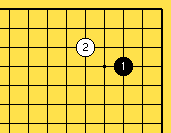
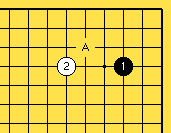
Dia 2 and dia 3 show moves
which prevent black from making a shimari. White's move 2 in
dia 2 is much more common than 2 in dia 3 since dia 3 actually
leaves a big piece of the corner to enclose, for example black
can play at A and secure at least 12 points.
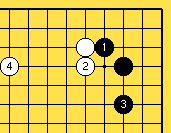
It is true that even in dia 2 black can secure about 12 points with the sequence shown in dia 2A.
This way of playing however, is regarded as giving too much
away for too little, it is rarely seen in professional games.
White's shape on the left side is nice and he has no complaints.
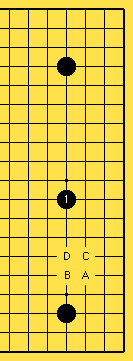
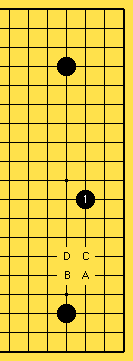
In dia 4 and dia 5 you can see
the so called high and low Chinese Fuseki patterns, this is an
intriguing way of playing since black's strategy by purposefully
not making a shimari is to invite white to play an approach move
to the corner (kakari) at A-D. If white plays here black hopes
to put his stone at the side, 1 to good use and make it hard
for white to settle himself. White most of the time declines the
invitation and plays somewhere on the left side instead.
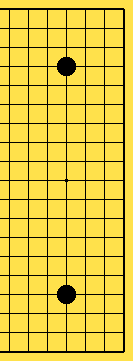
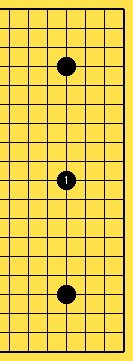
(Ikezaki) "Go Seigen for his part was more concerned with speed than anything else. He felt that taking time to solidify the corner with 2 moves was much too laid back an approach to the game, especially when playing white" (games in Japan during the first half of this century were largely played without komi and black had the advantage of playing the first move).
Kitani and Go might have had different goals in mind but they both came around to the same conclusion, komoku (4-3) or other asymmetrical opening moves (5-3, 5-4) need a follow up move (again in the corner) and do not develop towards the center and also do not develop one's stones very fast.
This was why they made the hoshi (4-4) play a standard opening move, and, a little after that the ni-ren-sei (dia 6) and san-ren-sei (dia 7).
(Ikezaki) "That Kitani and Go's views differ is best explained by the san-san (3-3) move Go came up with. Anybody can see that such a low move does not do much towards the center. Go, however, was perfectly content with it because, similar to the hoshi play the san-san move does not require a follow up move, enabling black to develop rapidly."
Nowadays the 4-4 move is extremely popular because of its
relative simplicity and speedy development. Of course however,
there is one major drawback to the hoshi play: on its own it
barely makes any territory at all!
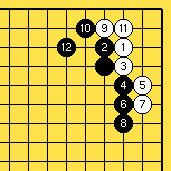
Dia 8 As long as black has not any stones in
the vicinity white can enter the corner at 3-3 and for example,
initiate the joseki up to black 12. Black plays the last move
here (he ends in 'gote') and white can play elsewhere first
(he has 'sente'). For black the idea of omitting 12 and play
elsewhere is not an option, since white will cut immediately
left of 2, ruining black's position. So, although black played
in the corner first his opponent can invade at the 3-3 point,
make 10 points of territory and play elsewhere (tenuki) first!
Put it like this and you might have a hard time believing that
this result actually favors black, big time. In spite of all the
aforementioned, black's thickness is usually worth much more
than the 10 points white took in the corner. For one thing,
after white invaded black can chose where he wants to block off
white. If at 2 in the diagram his thickness will come to face to
the left. If 2 at 3 black's wall will come to face the lower
half of the right side.
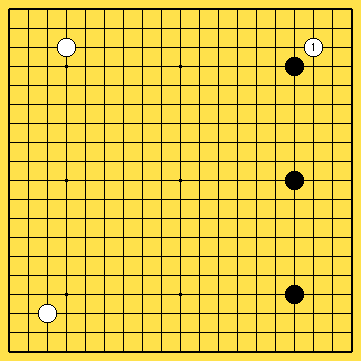
Realizing this white should think twice before deciding to jump
into the corner in dia 9. Playing at 1 here is
bad timing: black has no problem giving up the corner in order
to create formidable thickness, which might well turn out to be
worth over 40 points!
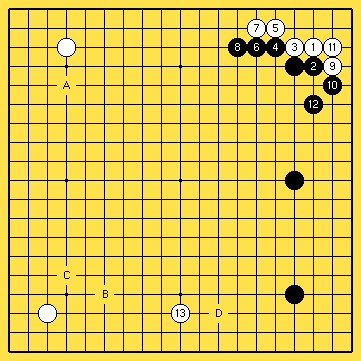
This is shown in dia 10 where you can see that black gets a promising game right from the start. After white 13 black does not need to do anything special, a play at A is good enough. If black really wants to he can see what happens if he plays at B, white C and black D. Black can permit himself to create a potentially weak group (stone B) in white's sphere of influence since his overall board position is rock-solid. By the way, black cannot play around 13 first and forget about playing at 12.
Whatever happens one thing to keep in mind when looking at dia
10 is that black should not look at his position on the right
as being secure territory yet. Using the right side to set up a
moyo (oversized teritory) of roughly the size of for example 80+
points is a good idea. For example a play at A (instead of black
1) in dia 11 shows the right spirit. To think however, that
black now quickly must at least secure 40 points of territory as
compensation for losing the corner is a mistake. Such a rigid
state of mind is easily exploited by white who can play a number
of forcing moves on the borderline of black's territory. If
black docile were to answer all white forcing moves (kikashi)
protecting his territory it'll be inevitable that black turns
out to be using too many stones to secure a small part of the
board (kori-gatachi).
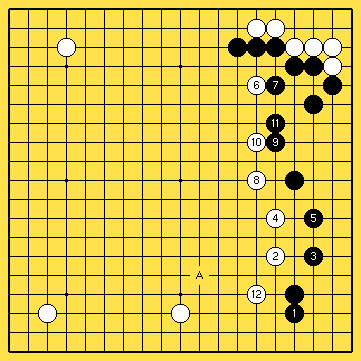
Black 1 in dia 11 is on its own maybe not such a bad move. However, if black 1 is played with the idea of securing black's territory as fast as possible then it is no good. The sequence up to 12 shows a worst case scenario. White doesn't even need to bother with an invasion on the right side (although this is of course possible) in order to get a promising game. If black is set on making the right side into solid territory he'll defend at 3-11. These moves disregard the proper usage of thickness and lack in fighting spirit. Black, to be sure, does get solid territory, about 40 points but he normally should not be able to win this game, his stones are all concentrated on the right side and much too singular in their purpose (they do not attack or threaten to do anything)
In other words, it is often not advisable to try to use a hoshi
stone in a territory-oriented manner right from the start.
Therefore, if at an early stage of the game your opponent
chooses to enter at the 3-3 point this should often be welcomed!
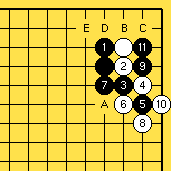
Dia 12 Let's take a closer look at what to do after white's 3-3 invasion. It is worthwhile to memorize at least three variations by heart. The sequence shown in dia 8 is number one and the most peaceful.
The ni-dan-bane combination with black 3 and 5 (double diagonal
move) is very popular since this usually lets black get the
corner back. Although white might sometimes want to play
elsewhere (tenuki) after black 11 a play at A is extremely big.
Not only does white make his position virtually invulnerable, he
also can aim at exploiting the lack of liberties of black's
1-3-7 stones. After white A, black elsewhere, white B, black
C, white D and black E, black can only just capture the white
stones because he has one liberty more. He should, however, be
very careful what happens to his own outside liberties during
the game.
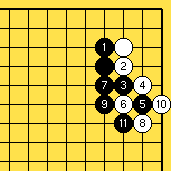
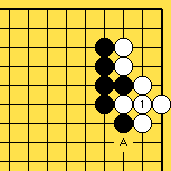
Note that the cut at 9 is just one possible continuation,
sometimes high ranked players prefer to let white have the
corner and instead of black 9 play dia 13. By
playing on the outside with 9 black clearly goes for thickness
towards the left and center instead of taking profit in the
corner. Another aim however, could very well be to obtain sente
by playing elsewhere in case white connects the ko with 1 as
in dia 14. But, black must be prepared for a
tricky ko fight if white does not connect at 1 but instead
counters his atari with A. Finally the last variation, and a
tricky one at that.

Dia 15 White 1 and 3 are testing black's
intentions and perhaps also his knowledge of joseki. White 3
shows excellent fighting spirit, aiming at the double atari at A
in spite of the obvious weakness of white's own stones. If black
were to play at B next white would without hesitation play A,
and whatever the continuation get a good result.
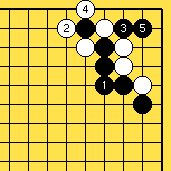
Dia 16 shows how to keep things simple and get
a good result for black. Although the sequence starting with
black 1 is a basic joseki I think that black has a nice corner
with no hidden nastiness (warui aji) waiting around to haunt
him. White'd better be sure his shape at the left (ponnuki)
is serving some kind of purpose there taking the whole board
situation in account, otherwise he should stick to the sequence
shown in dia 12.
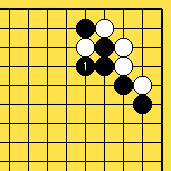
The reason why I called this variation tricky is this forceful
move black 1 in dia 17, which black sometimes
can play if he is careful.

Dia 18
If white has to defend with 2 and 4 then black can get a solid, thick
position. This result favors black.
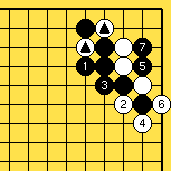
Dia 19 When white tries to fall back on the
original joseki (dia 12) and captures a black stone with 2-4-6
the result is a disaster: the triangle marked stones have now
become wasted moves.
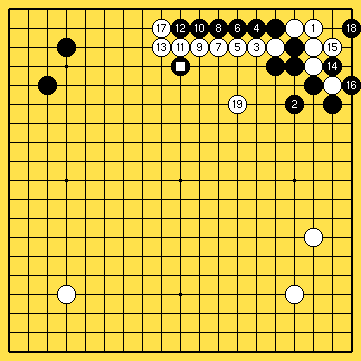
Dia 20 This diagram shows how frightening joseki can be. Moving out with 3 white sets his stone in motion instead of making eyes in the corner at 14 (=4 in dia 18), and in doing so is sacrificing the corner but?
Although no black stones die he is losing the game already once the sequence up to white 19 is set in motion. Crawling on the second line is not to black's liking but you can say that he captures the corner as compensation for that. The position of the square marked black stone however, is pitiful having all but died being plastered against the white stones as it is. Furthermore, attacking the white stones has become pretty difficult and black's shimari is not doing much, black is bound to loose this game because of a lack of territory.
Black 1 in dia 17 is sometimes possible but shouldn't be played
lightly.
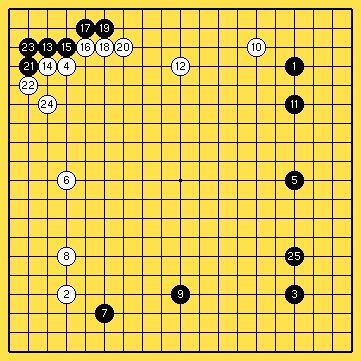
Dia 21
To give you an idea of when a pro plays under the 4-4 point
of his opponent let's take a look at dia 21. This is a game
between Japanese top pro's. In case of white's 4-6-12 formation
is entering at the 3-3 point, like in the game, often something
to consider. Once black invades it is difficult for white to
put both 6 and 12 to optimal use. In this game white's
exchange of the moves 10-11 as well was the position of 12 is
not entirely to his liking. Black 25 is a moyo making move still
leaving white some room to enter. It is, however, not so easy to
tell when and where white should play.
(Shimamura
Toshihiro versus Fujisawa Hosai, 1961,
black wins by resignation in 171 moves).
That was all for this time. What happened with Mr. Ikezaki? Well, the conversation was not going very smoothly to start with, him muttering to the ceiling and all. After a couple of remarks Mr. Ikezaki seemed to totally surrender to his thoughts. When the silence had continued for 10 minutes I decide to leave him in peace and went out for lunch.
Be sure to come back next month for the next episode of "Gentle Joseki"
__EOF
),
);
////////////////////////////////////////////////////////////////////////
//
// INDEX
//
$cnt_index = array(
array( 'type' => 'i'
, 'tag' => '008'
, 'img' => array(array('indx-02', 133, 133),)
),
array( 'type' => 'i'
, 'tag' => '012'
, 'img' => array(array('indx-03', 133, 133),)
),
array( 'type' => 'i'
, 'tag' => '012'
, 'img' => array(array('indx-04', 133, 133),)
),
array( 'type' => 'i'
, 'tag' => '013'
, 'img' => array(array('indx-05', 133, 133),)
),
array( 'type' => 'i'
, 'tag' => '015'
, 'img' => array(array('indx-06', 133, 133),)
),
array( 'type' => 'i'
, 'tag' => 'dia02A'
, 'img' => array(array('indx-07', 133, 133),)
),
);
////////////////////////////////////////////////////////////////////////
//
// NAMES (no names)
//
$cnt_names = array(
array( 'type' => 'n'
, 'name' => 'Go Seigen'
, 'text' => <<<__EOF
(1914-)
Japanese reading of his Chinese name
Wu Qing-yuan.
The unrivaled go genius of the 20th century. Although he is
approaching 90 now professionals like
O Rissei
and (until she moved to Korea)
Rui Naiwei
still recognize his genius and attend study sessions at Go's
house in Tokyo. For more about Go Seigen read
Mindzine.
Go is, by the way, a family name.
This, very appropriately, makes people address him as "Mr. Go",
or "Go Sensei" (lit. "Go Master") in Japanese.
__EOF
),
array( 'type' => 'n'
, 'name' => 'Ikezaki'
, 'text' => <<<__EOF
Family name,
Ikezaki Tokinori
(1956-) is a 4 dan pro from central Japan
__EOF
),
array( 'type' => 'n'
, 'name' => 'Kitani'
, 'text' => <<<__EOF
Family name,
Kitani Minoru
(1909-1975) was, together with Go Seigen the founder of the "Shinfuseki".
For more about Kitani read
Mindzine
__EOF
),
array( 'type' => 'n'
, 'name' => 'Yasunaga'
, 'text' => <<<__EOF
Family name,
Yasunaga Hajime
(1901-1994)
was editor for the Nihon Ki-In and pro level amateur Go player
__EOF
),
);
////////////////////////////////////////////////////////////////////////
//
// TERMS
//
$cnt_glossary = array(
array( 'type' => 'n'
, 'name' => 'aji'
, 'text' => <<<__EOF
taste; remaining possibilities, however distant they may be
__EOF
),
array( 'type' => 'n'
, 'name' => 'atari'
, 'text' => <<<__EOF
"check" on at least 1 stone
__EOF
),
array( 'type' => 'n'
, 'name' => 'dan'
, 'text' => <<<__EOF
ranking system for stronger players
__EOF
),
array( 'type' => 'n'
, 'name' => 'fuseki'
, 'text' => <<<__EOF
opening
__EOF
),
array( 'type' => 'n'
, 'name' => 'gote'
, 'text' => <<<__EOF
not being able to leave the current situation first,
allowing your opponent to be able the play elsewhere first
__EOF
),
array( 'type' => 'n'
, 'name' => 'hoshi'
, 'text' => <<<__EOF
star; any of the 9 dots one the go board,
the middle one is called "Tengen" (=center/origin of heaven).
Hoshi is often used when talking about an opening move
on the 4-4 point.
__EOF
),
array( 'type' => 'n'
, 'name' => 'joseki'
, 'text' => <<<__EOF
a sequence of moves (in the corner) giving both players
a locally equal results
__EOF
),
array( 'type' => 'n'
, 'name' => 'kakari'
, 'text' => <<<__EOF
approach move to the corner
__EOF
),
array( 'type' => 'n'
, 'name' => 'kikashi'
, 'text' => <<<__EOF
a move which is almost impossible to ignore, also "forcing move"
__EOF
),
array( 'type' => 'n'
, 'name' => 'ko'
, 'text' => <<<__EOF
situation which occurs when it is possible to
immediately re-capture the stone your opponent played
in the previous move to capture 1 of your stones. Since
there is no end to this there is the ko-rule, which
prohibits a player to exactly recreate a previous board
position.
__EOF
),
array( 'type' => 'n'
, 'name' => 'komi'
, 'text' => <<<__EOF
compensation for white (usually 5-7 points) since black
gets to play the first move. (often there is a half
point komi, as in 5.5 stones komi, to prevent a game
from ending in a draw)
__EOF
),
array( 'type' => 'n'
, 'name' => 'komoku'
, 'text' => <<<__EOF
the 4-3 point
__EOF
),
array( 'type' => 'n'
, 'name' => 'kori-gatachi'
, 'text' => <<<__EOF
inefficient shape, uneconomical, using to many stones
to make only few points (hollow wall)
__EOF
),
array( 'type' => 'n'
, 'name' => 'kyu'
, 'text' => <<<__EOF
rating system used for intermediate players
__EOF
),
array( 'type' => 'n'
, 'name' => 'miai'
, 'text' => <<<__EOF
of equal value
__EOF
),
array( 'type' => 'n'
, 'name' => 'moyo'
, 'text' => <<<__EOF
large framework often forcing the opponent to (try to)
reduce it drastically in order to stay in the game
__EOF
),
array( 'type' => 'n'
, 'name' => 'ni-ren-sei'
, 'text' => <<<__EOF
two 4-4 moves one the same side of the board
__EOF
),
array( 'type' => 'n'
, 'name' => 'ponnuki'
, 'text' => <<<__EOF
the name of the shape when 4 stones capture one enemy stone
__EOF
),
array( 'type' => 'n'
, 'name' => 'san-ren-sei'
, 'text' => <<<__EOF
3 hoshi of the same color at the same side of the board
__EOF
),
array( 'type' => 'n'
, 'name' => 'sente'
, 'text' => <<<__EOF
having the opportunity to play elsewhere first leaving
the current situation. (example: he had sente so he
decided to play tenuki)
__EOF
),
array( 'type' => 'n'
, 'name' => 'shimari'
, 'text' => <<<__EOF
"closing" (the corner) formation, any 2 moves which effectively
seal the corner, also "enclosure".
__EOF
),
array( 'type' => 'n'
, 'name' => 'shin-fuseki'
, 'text' => <<<__EOF
"New Opening" a way of playing starting in the 1930's
which does not accept the go-theory of the 19 century as
being without its weak points.
__EOF
),
array( 'type' => 'n'
, 'name' => 'tatami'
, 'text' => <<<__EOF
thick mats of woven rush stuffed with straw, traditional flooring
__EOF
),
array( 'type' => 'n'
, 'name' => 'tenuki'
, 'text' => <<<__EOF
playing else first when judging the current situation
does not require an immediate follow up
__EOF
),
array( 'type' => 'n'
, 'name' => 'warui'
, 'text' => <<<__EOF
bad
__EOF
),
);
////////////////////////////////////////////////////////////////////////
//
// EPILOGUE
//
// $cnt_epilogue = <<<__EOF
// __EOF;
?>
( ! ) Notice: Undefined variable: doc_info in /var/www/gobase.org/studying/articles/mioch/joseki/index.phtml on line 33 Call Stack # Time Memory Function Location 1 0.0004 357560 {main}( ) .../index.phtml:0
( ! ) Notice: Trying to access array offset on value of type null in /var/www/gobase.org/studying/articles/mioch/joseki/index.phtml on line 33 Call Stack # Time Memory Function Location 1 0.0004 357560 {main}( ) .../index.phtml:0
 |
An introduction to corner patterns, especially but not only meant for kyu players.
| |
 | ||
 | ||
 | ||
 |
The Patterns |  |
 | ||
 |
|  |
||||||||||||||||||||||||||||||
 | ||||||||||||||||||||||||||||||||
 | ||
 | ||
 |
Appendix 01 |  |
 | ||
 |
Index of joseki's mentioned in this episode:
|  |
||||||||||||||||||||||||||||||
 | ||||||||||||||||||||||||||||||||
 | ||
 | ||
 |
Appendix 02 |  |
 | ||
 |
Japanese words and their English equivalents used in this article: |  |
 | ||
 | ||
 | ||
 |
Copyright © Pieter Mioch |  |
||||||||||||||||||||||||||||||
 | ||||||||||||||||||||||||||||||||
 | ||
 |
home | index | about pieter mioch | part 1 |
 |
 | |||
 |
home > studying > articles > pieter mioch > gentle joseki part |
Feedback: editor@gobase.org |
 |